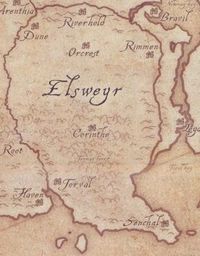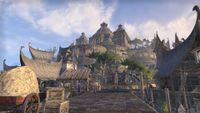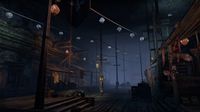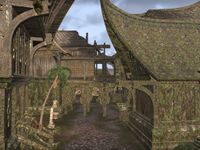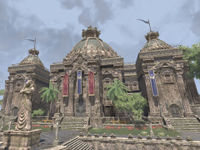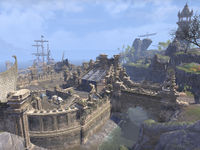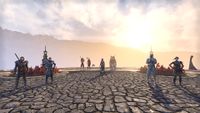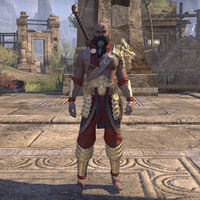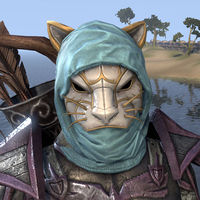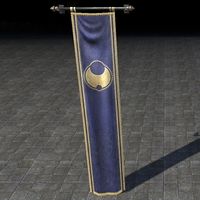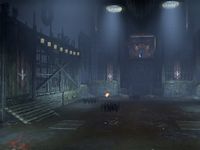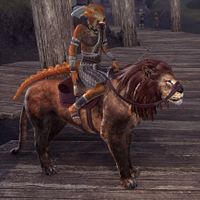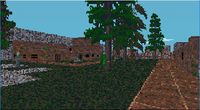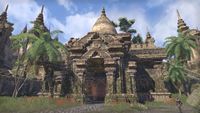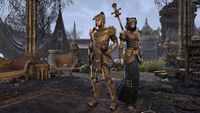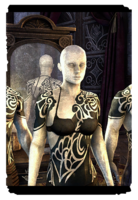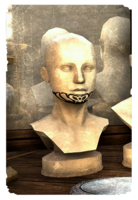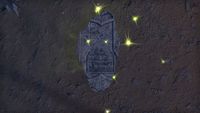Lore:Senchal
| Senchal | |
|---|---|
| Type | Settlement |
| Continent | Tamriel |
| Province | Elsweyr |
| Region | Pellitine (Quin'rawl) |
| Appears in | Arena, ESO |
|
Senchal (also spelled Senchel)[1] is one of the eight major cities in the province of Elsweyr,[2] and its ruler has historically governed the southern kingdom of Pellitine.[3] A densely-populated settlement replete with bazaars, taverns, and open-air markets, Senchal is one of the largest ports in southern Tamriel. It is also an infamous haven for pirates, thieves, the black market, and other criminal activity. Over Senchal's long history, the city has been wracked by numerous destructive fires and plagues, but it has survived these crises and been rebuilt each time.[3][4]
Layout and Geography[edit]
Senchal is located on the Quin'rawl Peninsula,[4] the coastal highlands of southern Elsweyr. More importantly, the city sits at a significant spot on the southern ocean, between the Topal Bay and the Southern Sea.[1] On the mainland, the city is based in a hot, tropical region called the Scorch, the ruined outcome of the Knahaten Flu hysteria in the mid-Second Era.[5] Under the Third Empire, it was the capital of the eponymous Kingdom of Senchal in southeast Elsweyr.[6] The city is neighbored by several settlements, one of them includes South Guard to the west.[2]
Senchal is a large, walled city surrounding the palace in its center and built on a cliff overlooking the northeast coast. As it spreads out, the city gradually descends southwest into the central valley of the region and drastically northeast to the coast. The center of Senchal is a large open street anchored by the wayshrine, the palace, and the local bank. Archs on the western wall lead into the rest of the city. The southwest portion of Senchal is layered three times by walls and by the latter half of the Second Era, the further out it goes, the more derelict and ruined the city is. The main street on this other side of the wall is a large thoroughfare with a sidewalk. South toward the merchant's square, the road becomes narrow. The final layer is completely ransacked and anyone that lives there lives in makeshift homes built on the side of the wall or the decrepit houses.[7]
The northeast, however, is a steep incline to the waterfront. The Palace's back courtyard stands tall above the bay and the broad, northern street wraps around it at the bottom. Large stairs along the courtyard's foundation bring the street lower and lower to the waterfront. Some parts of the city, like the parkland around the crypts in north Senchal and the eastern part of the city, have an unkempt architecture with overgrown vines and greenery. Outside of the outermost wall are abandoned buildings and crumbled temples. The main road runs around the city's wall and enters the city from the west, southwest, east, and north via the harbor.[7]
Notable Locales[edit]
|
|
Districts[edit]
|
|
History[edit]
Early History[edit]
In ancient history, the land that would become Elsweyr was divided between sixteen clans of Khajiit, each with a mastery of a different trade or a unique quirk. What is known about Senchal's earliest history comes from songs and stories passed down over generations by these clans. Members of the Senchal clan were seasoned mariners and shipwrights, and they made their home on a landing site in the southern Topal Bay, where the modern-day city would be built. The clan sailed across the seas, traded with all sorts of people, and eventually amassed funds to create businesses and build dwellings. Fires occurred on the regular in these early days and to prevent further damage, they began to build with stone.[3]
A caste system developed between the merchants, traders, and raiders, and it was through this system, Black Kiergo was founded as a place to cater to the lowlifes while the rest of the city had its own districts based on social standing, including the clan leader's home.[3]
Dominance between the sixteen clans was determined by the phases of the moons, Masser and Secunda. If the moons were both at syzygy (both are new moons), then Senchal would wield the most power.[9] The sixteen clans were ruled under a single entity known as the Moon-Emperor[10] and as they were pushed into their roles and limited by geography, these clans gave rise to large kingdoms[11] and Senchal presided over the Quin'rawl peninsula, in southeast Elsweyr.
In 1E 2200,[12] the Thrassian Plague swept through most of Tamriel and many died in the chaos that ensued. Senchal was quarantined at the height of the plague. Not only were the city gates sealed, but the smuggler tunnels in Black Kiergo collapsed and trapped many people inside. In the hopes of killing the plague, some of the locals set the city on fire but the smoke polluting the air made it difficult to breathe. As a solution, some people will wear a wet cloth over their mouth, but it would only help so much. The fire eventually spread to the last remaining wood structures in Senchal and if the plague did not catch them, then the fire or smoke killed the rest of the population.[3][13]
Shift after the fall of the Sixteen Kingdoms[edit]
In the next several decades, Senchal saw a radical shift in political structure as the disparate clans of the south gathered in the city, the largest settlement at the time. Senchal's societal system became influenced by Bretons and Imperials that came into port and the Moon-Priests of the Pa'alatiin Clan provided the Khajiit with guidance and assistance through the trying times. These factors forever changed the landscape across Senchal and the south as more people came and went through the city, developing it into what we now know as Pellitine.[10]
The ruler of the city now governed the entire region and their main focus moving forward was to establish a sense of stability, even at the expense of what seemed "fair" or "just".[3] Eventually, when order was re-established, the Khajiit were able to continue their way of life.[10]
By the early years of the Second Empire, the kingdoms of Pellitine and Anequina were controlled by the Cyrodiils under Emperor Reman I.[14] And in the late First Era, Senchal was ruled by the Mad King Dro'Zel, who is most remembered for causing the destruction of Gil-Var-Delle, a town in eastern Valenwood. He summoned Molag Bal, the Daedric Prince of Domination to destroy the town after a bard from there told him the legend of Polydor and Eloisa, a classic story tied to Heart's Day.[15] Not long after that in 1E 2920, Dro'Zel was appointed an advisor to Emperor Reman III.[3]
By the early fourth century of the Second Era, Senchal was ruled by Queen Eshita and in 2E 309, she married the king of Anequina, Keirgo. It was a controversial decision between both kingdoms but the rift between them healed over time as they became the Elsweyr Confederacy. Eshita moved to the new capital, Ne Quin-al while the Akaviri Potentate took residence in Senchal Palace, a sign of the province's strong ties to the Empire. In 2E 324, the Potentate was assassinated in the palace by the Morag Tong, who sprawled their name on the wall with his blood. Some people believed that it was an attempt to mislead people but others genuinely believed it was them.[10] The Potentate's murder was one of many events that brought about the confederacy's decline two years later. Political instability soon took over Elsweyr and its people,[11] and Senchal fell back on their now-entrenched traditions and social structure, prevailing onward for the next two decades.[3]
The Knahaten Flu and the Scorch[edit]
With its suffering and injustice
When death hounded us.
But can we thrive after what we paid to get here?
Who are we now?
We dare not say.
The march of darkness goes on.
What can we do?
What have we become?
—Excerpt from "the Burning of Senchal"
Sometime in 2E 560, a disease known as the Knahaten Flu began to spread from Black Marsh, specifically Stormhold to the east.[16] Five years later,[3] the flu appeared among skooma addicts of Black Kiergo's Sweet Street and at first the city's elders dismissed it as a toxin, but it soon spread into Dagi's Pride and Squint-Eye.[8] Much like the disasters from the Thrassian Plague, Senchal's people went into full hysteria and quickly used fire to destroy the flu.[3]
The fires are remembered in history as "the Scorch" and it greatly affected not just the city, but the surrounding region.[17] Many people died from either the spreading fires or the choking black smoke rather than the Knahaten Flu itself.[3] Personal accounts from that time talk about how the debris caused by the fires blocked people from escaping and trapped them in pitch-black smoke.[18]
Ultimately, the flu scarred the region for centuries ever since. People from outside the city came to Senchal to help people recover from the flu, or even cure it but failed. They would at least comfort them before death.[19] While many people died in the wake of destruction, notable figures such as the governor of Senchal, Z'har Tasluz, and nobles of the Pellitine bloodline were also lost.[20] Even places like Black Kiergo were gone, with what remains of ground zero for the flu being driven underground.[21] For seventeen years,[Note 1] the city was cut off from the rest of Tamriel and without central leadership, pirates, thieves, and other criminals rose to places of power.[20]
Substantial help arrived when Emperor Varen Aquilarios sent the Thirteenth Legion to reinstate authority and law. When the Emperor disappeared only a couple years later, the legion was left to its own devices, but it remained dedicated to its mission. General Meric Renmus continued to govern the people and restore order to the land. The citizens of Senchal affectionately bestowed the legion with the name "the Shields of Senchal".[20] The Shields helped establish the Senchal City Council, which assisted them in the region's governance and lawmaking.[22] In time, Senchal became safer than it was years prior, and as the criminal element retreated to the shadows, the city entered a period of reconstruction.[20]
The New Moon Cult and the Dragon Incursion[edit]
In 2E 582, dragons sealed away for hundreds of years in the Halls of Colossus were released into the world and wrought mayhem across Elsweyr.[23] In Southern Elsweyr, several villages, and outlying settlements were destroyed by the dragon fires and many refugees began to flock to Senchal for protection. A former member of the Dragonguard, Sai Sahan traveled to the city to investigate and began to work with an adventurer in the area.[24]
After a failed attempt to recruit General Renmus to their cause, the two sailed for Tideholm with help from the general's daughter, Aeliah Renmus, and her friends; smugglers of the Perfect Pounce. In the ruins, they established their base and an alliance with a dragon roosted there named Nahfahlaar to defeat the threat to Tamriel.[24]
Back on the mainland, more and more refugees arrived in the city, and as the Shields of Senchal were stretched thin, tension increased to the point where chaos felt imminent. Soon enough, a cult of dragon worshippers called the Order of the New Moon appeared and began a campaign to recruit people across the area.[25] They preyed on the desperate and weak,[26] as well as skooma addicts and vagrants. In an effort to weed out undesirables, the order started to use the Black Kiergo Arena to pit them against each other, and only the strongest were guided to their headquarters out in the Tenmar Forest.[25]
In time, Aeliah convinced her father to assist the Dragonguard and General Renmus traveled to Tideholm to convene with Sai Sahan. With help from soldiers in the field, the group tracked the two warring dragons, Nahfahlaar and Laatvulon to the ruins of Doomstone Keep, where a final confrontation would commence. Despite their victory against the New Moon Cult and Laatvulon,[27] their final adversary, Kaalgrontiid was still at large. The newly-named Queen of Anequina, Khamira had traveled to the region to assist the Dragonguard, all the while hoping to recruit General Renmus and restore the Elsweyr Confederacy.[28] Together with Sai Sahan, Abnur Tharn, Nahfahlaar and their mutual associate, they raided Dragonhold one last time to defeat Kaalgrontiid.[29]
While they were elsewhere, the Dragonguard and Shields of Senchal banded together to defend Senchal should they be unsuccessful.[29] In the end, the Dark Aeon was destroyed and the threat to Elsweyr and Tamriel was over. Queen Khamira offered General Renmus the chance to join a restored Confederacy but it is unknown if he accepted it, or if the Shields of Senchal returned home to Cyrodiil. Regardless, a ceremony was held in Senchal Palace to commemorate their victory and the Dragonguard.[30]
Senchal in the Third Empire[edit]
When Elsweyr was caught up in the Tiber War, Senchal was attacked by the Imperial Legion in an event known as the Sack of Senchal. The battle was omitted in the Third Empire's official history. General Pottreid gave the city a chance to surrender but when they refused, the attack ensued. The legion massacred many people, from men, women, and children.[31] By the time the 1st Edition of the Pocket Guide was written, Senchal remained outside of the Empire's jurisdiction. Much of the city was abandoned and ruined as the city never did rebuild after the Scorch.[4] By the Third Era, the city was the seat of its own kingdom also called Senchal.[6]
During the Imperial Simulacrum in the late Third Era, the city-state of Senchal was an active settlement. It was ruled by King Huskir and had a rivalry with Alabaster.[32] Around the turn of the era, the city underwent a significant change from the largest port in the drug trade to a coastal resort for wealthy Khajiit, due in part to the increase in moon sugar manufacturing in the span of twenty years. Rumor in 3E 432 has it that Ya'Tirrje, the Gold Cat bought a valuable villa in Senchal and invested a lot of money into the city. They helped pay for Senchal's abundant security that keeps the city safe and crime-free while also financing his large-scale drug smuggling business across the province.[9]
Known Rulers[edit]
The Harbor-Duke of Senchal
Sailors and stevedores of the ports
The nautical knaves of Senchal
—Excerpt from "The Sixteen Kingdoms"
Senchal was the favored home of the eponymous clan of nautical Khajiit and these clans are typically governed by a clanfather or clanmother. When the Pa'alatiin clan assumed power over the southern region of Elsweyr, Senchal and its ruler now governed Pellitine as Kings or Queens.[10] In the traditional Khajiiti child's chant, The Sixteen Kingdoms, Senchal's ruler is referred to as the Harbor-Duke of Senchal.[33]
In the years prior to the Knahaten Flu outbreak, the leader of Senchal was called the Governor. The last known person to hold this title was Z'har Tasluz, who died in the aforementioned plague. In the next several years, Senchal was controlled by criminals across the land, and oppression defined this era in the city's history. After the Thirteenth Legion came brought peace to Senchal, its leader, Meric Renmus helped established the Senchal City Council.[20][34] By the Third Era, Senchal was once again ruled by a King or Queen, but they governed the entire kingdom of Senchal.[6][32]
- The First Era
- The Second Era
- The Third Era
Culture and Society[edit]
Senchal has a long and storied reputation as a city of thieves and criminal activity,[4] so much so there is a sort of universal credo among thieves that Shan-ra, a leader of merchants in Redfur Trading Post called the "Senchal life". In Senchal, thieves will flaunt their abilities and keep others in check, while looking out for the less fortunate and keeping enough for themselves to survive, living a sort of lifestyle where one can depend on another.[36]
The city's thievery originated from its early years when the caste system was first developed. Black Kiergo became a haven for the malcontent and legends claim that Rajhin, the Cat-King of Thieves was raised in these slums.[3][37] One of his own shadows claims that there are still parts of the city that only he knows.[38] Although some criminals operate in broad daylight, many have taken shelter in the city's sewer system ever since they were built and turned it into the outlaws refuge.[39]
Senchal is the largest port in southern Tamriel,[4] with ships coming from as far as Solitude.[40] Under the Third Empire, it was a major port in the East Empire Company's southern line. It is connected to the cities: Alinor, Leyawiin, Soulrest, and Southpoint.[41] Ships that dock into the city are required to undergo cargo inspection unless they provide a sanctioned ship's manifest.[42] The city's history with sailing and shipping dates back to the original Senchal clan.[3]
The city's black market can host a wide selection of goods,[4] even items of moral ambiguity. If one were to desire fresh corpses then a vendor can provide one. There are even rumors spurred that the Sload will carry corpses from Senchal via their airships.[43] There is also a readily available market in both Senchal and nearby Torval for relics from the Anequine Conquests, especially those that date back to Darloc Brae's reign over northern Elsweyr in the early First Era.[44]
Khajiiti society across the province reveres the moons, Jode and Jone, and Senchal is no different. The city's banner, a blue and gold tapestry reflects this by featuring lunar symbolism.[45] As stated earlier, when the two moons were at syzygy (new moons), Senchal would have the most power among the ancient sixteen kingdoms.[9] The phases of the moon also correspond to which furstock a Khajiit is born into, and in this case, it is a Suthay.[46] The Senchal Palace houses a priceless tapestry known as the Khajiit of the Moons, which the wealthy Khajiit trader, Bebbia Sleek-Fur called, "a symbol of Senchal's status".[47]
The heat and tricky terrain of the Senchal region has influenced the type of armor and clothing found in the city. Due to the heat, the inhabitants of Southern Elsweyr are prone to contract an affliction called Scorch-Paw, which has led to a common preference for open-toed and flexible footwear. Stiff metal armor or anything inflexible is rarely seen here as it hinders movement in the area.[48] Curried Fish and Rice is a dish served in the city[49] and Senchal Dancer Tonic is a soft drink made from isinglass, jasmine, yerba mate.[50] There are several unique animal species living around Senchal, such as the Senchal Harbor-Mutt,[51], the Horned Owl,[52] and the Senchal Striped Cat.[53]
Legacy of the Knahaten Flu[edit]
The Knahaten Flu outbreak was a significant point in Elsweyr's history as it took a lot of time for its people to recover.[8] Some would say that of any part of the province, Senchal, and southern Elsweyr were affected the most.[54] Even by the Tiber War of the late Second Era, remnants of the Scorch hysteria were still present.[4] "The Burning of Senchal" was music inspired by the events that transpired and reflects upon the time since then.[55]
The fires also affected the local wildlife as many local Senche-Lion prides moved into the area. Some Khajiit would actually domesticate these animals and train them as mounts in the dragon conflict of the mid-Second Era.[56]
Black Kiergo, traditionally a district on the surface was stamped out in the Scorch and for the longest time, remained underground as a part of the outlaws refuge. From there, it became a fighting arena, one that attracted people from all over Tamriel. Nobles would invest in these fights for entertainment while warriors entered to prove their mantle.[21] By the late Second Era, Black Kiergo was back on the surface but it is unknown what became of the arena.[4]
Gallery[edit]
Notes[edit]
- Arena was originally conceived as a fighting game featuring a tournament that took the player to each of Tamriel's cities to challenge different gladiatorial teams. According to a file from that stage of development left behind in the final game, Senchal's gladiatorial team would have been called "the New Gods".[UOL 1]
See Also[edit]
- For game-specific information, see the Arena and Elder Scrolls Online
 articles.
articles.
Books[edit]
- The Burning of Senchal — Song lyrics about the Scorch
- History of Senchal: An Overview by Sulema, Initiate Scholar of the Pa'alatiin — An overview of the history of the city of Senchal
- The Shields of Senchal by Ziri, Chronicler of the Senchal City Council — An overview of the Thirteenth Legion's time in Senchal
- The Sixteen Kingdoms — A traditional chant about the sixteen kingdoms of ancient Elsweyr
References[edit]
- ^ a b Map of Elsweyr – Pocket Guide to the Empire, 1st Edition
- ^ a b Map of Elsweyr – The Elder Scrolls: Arena
- ^ a b c d e f g h i j k l m n History of Senchal: An Overview — Sulema, Initiate Scholar of the Pa'alatiin
- ^ a b c d e f g h i Pocket Guide to the Empire, 1st Edition: The Elsweyr Confederacy — Imperial Geographical Society, 2E 864
- ^ Scelian Celatus' dialogue in ESO: Dragonhold
- ^ a b c d The Brothers of Darkness — Pellarne Assi
- ^ a b c d e f g h i j Senchal in ESO: Dragonhold
- ^ a b c d e The Eagle and the Cat — Lord Gharesh-ri, Speaker for the Mane
- ^ a b c Pocket Guide to the Empire, 3rd Edition: Sugar and Blood: the Cats of the South — Imperial Geographical Society, 3E 432
- ^ a b c d e f History of Pellitine: An Overview — Sulema, Initiate Scholar of the Pa'alatiin
- ^ a b Anequina and Pellitine: An Introduction — Sulema, Initiate Scholar of the Pa'alatiin
- ^ Systres History: Volume 3 — Trilam Heladren, Associate Dean of Eltheric History, University of Gwylim
- ^ Black Kiergo: Primed for Peryite? — Yamighu
- ^ A Legionary's History of Fort Redmane — Pristan Vinicio, Centurion, 19 Sun's Dawn, 2E 233
- ^ a b 2920, Sun's Dawn — Carlovac Townway
- ^ a b Pocket Guide to the Empire, 3rd Edition: The War with the Trees: Argonia and the Black Marsh — Imperial Geographical Society, 3E 432
- ^ Daini's dialogue in ESO: Dragonhold
- ^ Fleeing Senchal — Riifa, Itinerant Healer
- ^ Journal of Thracius Mento — Thracius Mento
- ^ a b c d e f g The Shields of Senchal — Ziri, Chronicler of the Senchal City Council
- ^ a b Caska's dialogue in ESO: Dragonhold
- ^ a b The Bounty and the Shields — Julia Runellius
- ^ The Halls of Colossus prologue quest in ESO
- ^ a b The Dragon's Lair story quest in ESO: Dragonhold
- ^ a b Order of the New Moon story quest in ESO: Dragonhold
- ^ New Cult or Ancient Religion? — Sulema, Initiate Scholar of the Pa'alatiin
- ^ The Dragonguard story quest in ESO: Dragonhold
- ^ The Dark Aeon story quest in ESO: Dragonhold
- ^ a b New Moon Rising story quest in ESO: Dragonhold
- ^ The Pride of Elsweyr story quest in ESO: Dragonhold
- ^ Attrebus' biography – The Elder Scrolls Adventures: Redguard
- ^ a b c Senchal location and rumors in Arena
- ^ The Sixteen Kingdoms
- ^ General Renmus' dialogue in ESO: Dragonhold
- ^ Tideholm loading screen text in ESO: Dragonhold
- ^ Shan-ra's dialogue in ESO
- ^ Varieties of Faith... — Brother Mikhael Karkuxor of the Imperial College
- ^ Rajhin's Shadow's dialogue in ESO: Elsweyr
- ^ Senchal Outlaws Refuge loading screen text in ESO: Dragonhold
- ^ Pocket Guide to the Empire, 1st Edition: Skyrim — Imperial Geographical Society, 2E 864
- ^ Map of the East Empire Company – The Elder Scrolls V: Skyrim
- ^ Sai Sahan's dialogue in ESO: Dragonhold
- ^ Corpse Preparation v I
- ^ Kuna's Delve loading screen text in ESO
- ^ Senchal Banner furnishing description text in ESO: Dragonhold
- ^ The Moon Cats and their Dance — Clan Mother Ahnissi
- ^ Bebbia Sleek-Fur's dialogue in ESO: Dragonhold
- ^ Crafting Motif 80: Shield of Senchal Style — Centurion Ancrus Vesnentia of the Shields of Senchal, Thirteenth Legion
- ^ Senchal Curry Fish and Rice in ESO
- ^ Senchal Dancer Tonic in ESO
- ^ Senchal Harbor-Mutt in ESO
- ^ Senchal Horned Owl in ESO
- ^ Senchal Striped Cat in ESO
- ^ Aburzin's dialogue in ESO: Elsweyr
- ^ The Burning of Senchal
- ^ Pellitine Scorch Senche-Lion mount description in ESO
- ^ Secret History of the Longhouse Emperors — Councilor Vandacia
Note: The following references are considered to be unofficial sources. They are included to round off this article and may not be authoritative or conclusive.

